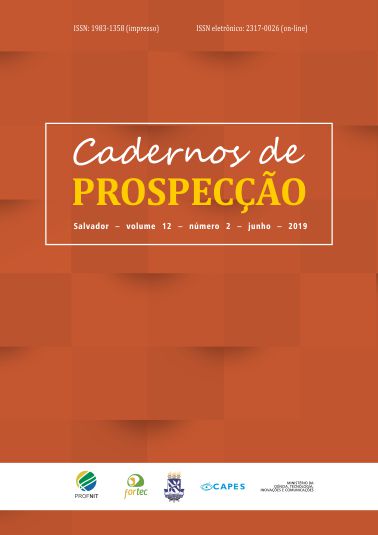Study and Technological Monitoring of Ultrasoom Use in Chemical and Membrane Processes
DOI:
https://doi.org/10.9771/cp.v12i2.27281Keywords:
Technological monitoring, Ppatent, Ultrassom, Polymer membranes.Abstract
This article refers to the study of monitoring of technological generation in the development of process using sleep chemistry, from the research of information in the main patent banks, such as the European Patent Office (EPO), the US Patent and Trademark Office (USPTO), the Brazilian National Institute of Industrial Property (INPI), among others. To obtain the information, the Questel Orbit® platform was-used, applying as input the keywords for the searches "sonochemical", "ultrasound", "membranes", “polymer”. We performed "macro", "meso" and "micro" analyzes, with the objective of raising the main technological characteristics related to the process using sleep ultrasound over the last years. Among the areas of ultrasound-related technologies, Chemical Engineering was the most prominent in the preparation and use of ultrasound in polymer membranes, accounting for 19% of the total. The main raw material used for the production / application together with the ultrasound was the polymer polyetherimide, also prominent for cellulose.
Downloads
References
ADEWUYI, Y. G. Sonochemistry: environmental science and engineering applications. Industrial & Engineering Chemistry Research, [S.l.], v. 40, p. 4681–4715, 2001.
ASHIRI, R; MOGHTADA, A; SHAHROUZIANFAR, A. Processing and characterization of carbonate-free BaTiO3 nanoscale particles obtained by a rapid ultrasound-assisted wet chemical approach. Metallurgical and Materials Transactions B, [S.l.], v. 46, p. 1912–1923, 2015.
BISCEGLI, C. I. Conceitos da Física do Ultra-som. São Carlos: Embrapa, 2003.
CHEN, D. Applications of ultrasound in water and wastewater treatment. In: CHEN D, SHARMA, S. K, MUDHOO, A (Ed.). Handbook on application of ultrasound: sonochemistry for sustainability. Boca Raton: CRC Press, Taylor & Francis Group, 2012.
CHITARRA, G. S. Aplicação do método da sonoquímica na avaliação da degradabilidade de polímero. 2013. 34 f. Trabalho de conclusão de curso (Bacharelado em Engenharia Química) – Universidade Federal do Rio Grande do Sul. 2013.
CHOWDHURY P.; VIRARAGHAVAN, T. Sonochemical degradation of chlorinated organic compounds, phenolic compounds and organic dyes-a review. The Science of the Total Environment, [S.l.], v. 407, p. 2474–2492, 2009.
DESTAILLATS, H.; HOFFMANN, M. R.; WALLACE, H. C. Sonochemical degradation of pollutants. In: TARR M. A. (Ed.). Chemical degradation methods for wastes and pollutants. Environmental and industrial applications. USA: Marcel Dekker, Inc., 2003.
GOGATE, P. R.; SUTKAR, V. S.; PANDIT, A. B. Sonochemical reactors: important design and scale up considerations with a special emphasis on heterogeneous systems. Chemical Engineering Journal, [S.l.], v. 166, p. 1066–1082, 2011.
GOODWIN, T. J. Equipment. In: MASON, T. J. Critical Reports on Applied Chemistry. Elsevier Chemistry With Ultrasound, London, v. 28, p. 159–187, 1990.
KODA, S.; YASUDA, K. Sonochemical Engineering Processes. Sonochemistry and the Acoustic Bubble, [S.l.], v. 1, p. 151–169, 2015.
KYLLONEN, H. M.; PIRKONEN, P.; NYSTROM, M. Membrane filtration enhanced by ultrasound: a review. Desalination, [S.l.], v. 181, p. 319–335, 2005.
LAMMINEN, M. O; WALKER H. W. Weavers.Mechanisms and factors influencing the ultrasonic cleaning of particle-fouled ceramic membranes. Journal of Membrane Science, [S.l.], v. 237, p. 213–223, 2004.
MOGHTADA, A; ASHIRI, R. Enhancing the formation of tetragonal phase in perovskite nanocrystals using an ultrasound assisted wet chemical method. Ultrason Sonochem, [S.l.], v. 33, p. 141–149, 2016.
PETERS, D. Ultrasound in materials chemistry. Journal of Materials Chemistry, [S.l.], v. 6, p. 1605–1618, 1996.
PILLI, S. et al. Ultrasonic pretreament of sludge: a review. Ultrason Sonochem, [S.l.], v. 18, p. 1–18, 2011.
PORTER, A. L. Technology futures analysis: towards integration of the field and new methods. Technological Forecasting and Social Change, [S.l.], v. 71, p. 287–303, 2004.
PRICE, G. J. Introduction to Sonochemistry. In: PRICE, G. J. Current Trends in Sonochemistry. Cambridge: The Royal Society of Chemistry, 1992. p. 1–7.
QUESTEL ORBIT. Orbit Intelligence. Disponível em: <https://www32.orbit.com/>. Acesso em: jun. 2018.
RAJ, B.; RAJENDRAN, V.; PALANICHAMY, P. Science and technology of ultrasonics. Pangbourne, UK, 2004.
RASTOGI, N. K. Opportunities and challenges in application of ultrasound in food processing. Critical Reviews in Food Sciences, [S.l.], v. 51, p. 705–722, 2011.
SUSLICK, K. S. Sonochemistry. Science, [S.l.], v. 247, p. 1438–1445, 1990.
______. The chemical effect of ultrasound. Scientific American, [S.l.], v. 260, p. 80–86, 1989.
TANG, W. Z. Physicochemical treatment of hazardous wastes. Boca Raton: CRC Press, Taylor & Francis Group, 2003.
THANGAVADIVEL, K. et al. Degradation of organic pollutants using ultrasound. In: CHEN, D.; SHARMA. S. K.; MUDHOO, A. (Ed.). Handbook on application of ultrasound: sonochemistry for sustainability. Boca Raton: CRC Press, Taylor & Francis Group, 2012.
VAJNHANDL, S.; MARECHAL, A. M. L. Ultrasound in textile dyeing and the decolourization/mineralization of textile dyes. Dyes Pigments, [S.l.], v. 65, p. 89–101, 2005.
VINATORU, M.; MASON, T. Comments on the use of loop reactors in sonochemical processes. Ultrasonics Sonochemistry, [S.l.], v. 39, p. 240–242, 2017.
Downloads
Published
How to Cite
Issue
Section
License
Copyright (c) 2019 Cadernos de Prospecção

This work is licensed under a Creative Commons Attribution-NonCommercial 4.0 International License.
O autor declara que: - Todos os autores foram nomeados. - Está submetendo o manuscrito com o consentimento dos outros autores. - Caso o trabalho submetido tiver sido contratado por algum empregador, tem o consentimento do referido empregador. - Os autores estão cientes de que é condição de publicação que os manuscritos submetidos a esta revista não tenham sido publicados anteriormente e não sejam submetidos ou publicados simultaneamente em outro periódico sem prévia autorização do Conselho Editorial. - Os autores concordam que o seu artigo ou parte dele possa ser distribuído e/ou reproduzido por qualquer forma, incluindo traduções, desde que sejam citados de modo completo esta revista e os autores do manuscrito. - Revista Cadernos de Prospecção está licenciado com uma Licença Creative Commons Attribution 4.0. Esta licença permite que outros remixem, adaptem e criem a partir do seu trabalho para fins não comerciais, e embora os novos trabalhos tenham de lhe atribuir o devido crédito e não possam ser usados para fins comerciais, os usuários não têm de licenciar esses trabalhos derivados sob os mesmos termos.
Este obra está licenciado com uma Licença Creative Commons Atribuição 4.0 Internacional.








